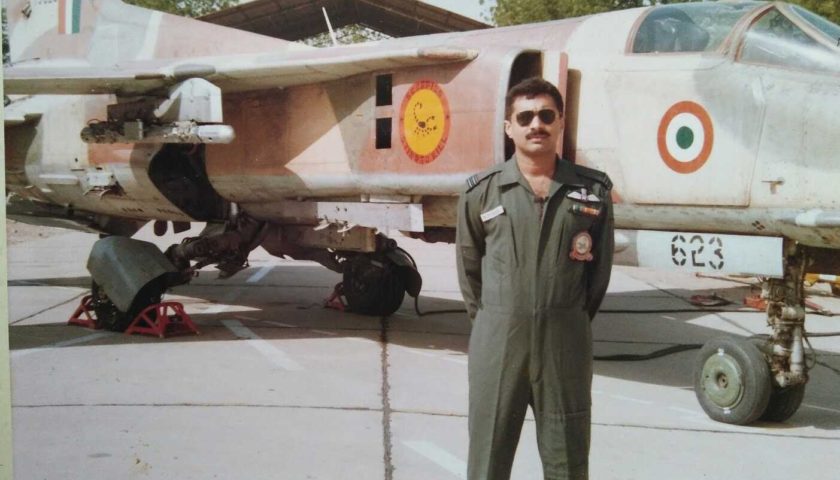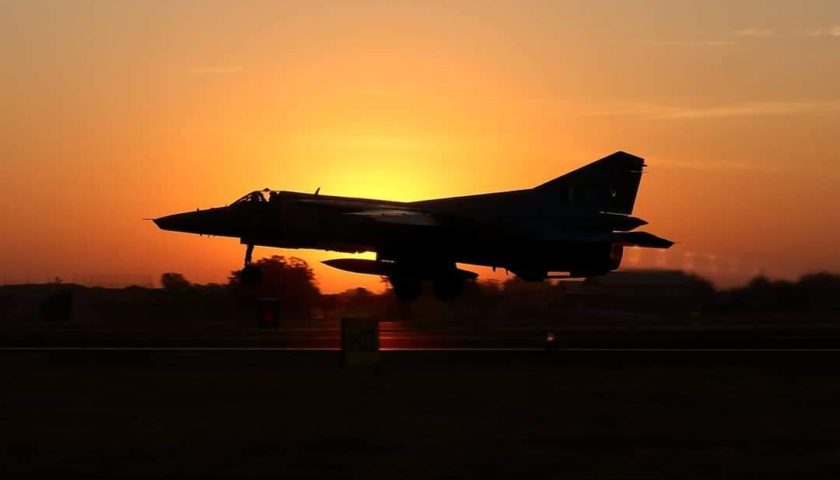After graduating from Air Force Academy Dundigal, it is training at a squadron which transforms young aviator into a military pilot. The pilots commissioned in fighter stream undergo specialized training in aerial warfare (air to air combat and air to ground combat). Fighter pilots are one of the most highly regarded and desirable positions of any air force. They possesses an exceptional academic record, physical fitness, healthy well-being, and a strong mental drive. As a combat pilot, successfully completing their missions is paramount, equal emphasis is given on their role as leaders and character models. Years of rigorous and dedicated training ensures that they are one of the most disciplined persons around, irresistible and irreplaceable!
In this article we will learn about the scrupulous and precise training that a fighter pilot undergoes.
Wings, Canopy, Line Up.
Flaps, Canopy, Take-Off.
Here we go along, on a ride with Gp Capt Nirmalendu Kumar (Retd).
- Tell us about your indoctrination and professional upbringing during the formative years as a 22-23 years young fighter pilot flying the MiG 21.
There are no secrets to success. It is the result of Preparation, Hard Work and Persistent Effort.
Our pilot course in Indian Air Force belongs to the famous ‘Top Gun’ era. The mind of a youngster, who had seen only 22 summers, is malleable and the famous shot of ‘Maverick’ zipping down the road into the setting sun enthused many in that period. Then, there was a Yamaha RX100 advertisement featuring a MiG-27 with a pilot in front. Motivated and driven by similar aims, when we stepped into a MiG-21 cockpit, we quickly realised that the hard work we had put in to earn our wings was only the tip of the iceberg. There was more hard work to follow if we were to truly live-by the “Second to None” attitude. The actual indoctrination and professional growth factually transpires in an operational squadron. The first operational Squadron that I was posted to, was packed with thoroughbred professionals and I consider myself fortunate to be posted to this wonderful Squadron. It was a MiG-21 unit that was employed in the Ground attack role, located next to an Air to Ground firing range and also next to the sea. All through the year, we had good weather, we had plenty of aeroplanes available on tarmac every day and we had Tactics and Combat Development Establishment (TACDE) as our neighbouring unit. Majority of senior pilots in the squadron were toppers of TACDE course who were ever willing to pass on their knowledge to us. What more could one ask for. It is worth mentioning here that I had my Charlotte “Charlie” Blackwood too in the city. (We got married a couple of years later)
The finest steel has to go through the hottest fire.
There is no substitute to hard work for success, but for us, hard work was mandated simply to be accepted as an integral part of that professional crowd in the unit. The epitome of professionalism in the squadron can be gauged from the actuality that after winning the Eklavya Individual trophy for Bomb dive in Under Trainee category in IAF, my Flight Commander firstly congratulated me and then asked me for an explanation for my second bomb not getting a Direct hit. He was a ruthless professional till the time he was in office, but after working hours, he would beat you hands down during a party.
On all working days, we always flew a minimum of 2-3 flights unless you goofed up during the morning “Emergency session”. If one goofed up, he could not touch the machine that day or in some extreme case for many days as a pilot. In-lieu one had to spend his working hours on tarmac learning to change aircraft tyre or refuelling (under supervision) the MiG-21s that came after flights. For the 2/3 flights, that we were planned to fly the next day, it required many hours of preparation. Help for this was always available in the form of other senior bachelors who were partners in crime for all the hoodlums we executed during off working hours but when it came to professionalism they were the ones who guided us, explained things to us, pulled us up and kicked our butts for our follies. In fact, we had a wonderful support network accentuating our professional growth in the form of bachelors. It was an unwritten rule that each evening, all bachelors shall get together in our garden area and there the junior lot had the opportunity to seek corrective actions for the mistakes done in flying for that day and also for seeking clarification for next day’s flying. Here I ain’t even hinting that the mistakes made in flying were not addressed during working hours under the watchful eyes of our Flight Commander. They were more than just ‘addressed’ but after a good dressing down when one is feeling like an eel, you want to save your face to the extent possible, by not asking presumably silly questions. The good part was that the bachelor lot exactly knew the shortfall and would explain things in detail during these daily meetings.
Flying the MiG-21 was a pleasure, to say the least. After about a year of flying this beautiful machine, one learns the art of taming this machine to make her do what you want. Aeroplanes are non-living but for a pilot when he is flying that machine, non-living (aeroplanes) always come alive and for Fighter blokes, these machines invariably always adopt a feminine form. Our days invariably stated with a 2/4/6 ship flight that ended up at Air to Ground range while we delivered our weapon load of bombs/rockets/guns. The flight comprised of flying at low-level, to evade radar, at speeds ranging in-between 700 kmph to 1000 kmph for 25- 30 minutes in a specific formation and then at the designated time and with an accuracy of 5-10 secs, we had to hit the target with actual weapon load. The weapon load varied on a day to day basis, in-between 57 mm rockets, bombs of up to 1000 pound calibre or guns of 23 mm calibre. To add to the excitement, somewhere during the low-level flying, there would be another aircraft that would attack us and we had to repulse the attack while still continuing towards achieving the aim of the flight. These attacks required a good amount of vigorous manoeuvring at low height above ground where only some odd seconds separated us from hitting the ground. Unlike today’s computer/mobile games that can be reset, hitting the ground can never be reset. Therefore the training was benchmarked to keep all safe firstly and then to ensure a good dependence for achieving the stipulated aim. The movie ‘Behind the Enemy lines’ in the epoch before the main character is shot down in enemy territory, gives a glimpse of the kind of flying that is done at low-level.
The second and/or third flight in the day, for most of us, included the practice of aerial combat. I am sure many can visualise this, as numerous western movies have portrayed this aspect. Doing aerial combat in a MiG-21 with another MiG-21 has some basic differences vis-a-vis other aerial war machines. There are numerous other differences on the facet of performance and technicality. However, without dwelling into those intricacies, merely have a look at the frontal profile of a MiG-21. Now imagine yourself 6-7 kms in the air from this machine and at the same angle. What would you see? Nothing !!!!!!! It is dart-shaped and hence at large distances, one sees nothing of this aircraft when viewed from the front. So, to visually acquire a MiG-21 in air, one has to train his eyes and practise endlessly to pick up these darts. No training goes waste and the training of a MiG-21 pilot’s eyes many decades ago would still assist them in visually acquiring, for personal appraisal only, of course, other aircraft of 60 ton and above category, at rather large distances. This is what I enjoy doing these days.
Our unit pilots were required to be qualified to fly oversea. We would therefore fly in a single-engine aircraft at low height over the sea at speeds of 800 to 900 Kmph. These were always a 2 ship formation where both pilots kept a hawk-eyed watch over the other. Flying into wide blue yonder at these heights, where the demarcation between sky and ground is undistinguishable was exhilarating, to say the least, and once again any distraction could result in a disaster within a couple of seconds. We were often light-heartedly informed that the Gulf of Kutch where we generally operated had sharks and if we were not desirous of becoming their snacks, we better fly safely.
Flying the MiG-21 was an experience that can truly be apprehended by another MiG-21 pilot only. We lived life to the fullest, professionally as also socially. We worked hard and partied harder. The unit was one big family. Asking for Annual Leave was replaced by being forced to take leave. Professionally as a unit, we could easily get the Eklavya Trophy, got good assessments from inspecting agencies while on the social front, our parties were always the talk of the town. As a youngster, we could not have asked for more.

- Within a couple of years of gaining operational experience on MiG-21, you graduated over to MiG-27. Please elaborate on the experience and differences.
Revving up a Lamborghini would certainly be different from a Limousine. While the metaphor will certainly be objected by the elite of both these machines, the essence would hold true.
After four years of flying the MiG-21, my unit was re-equipped with MiG-27 aircraft. It is untold truth that one must avoid at all costs, some events in a unit viz. Unit re-equipment with a new aircraft, unit relocation and President’s Standard presentation to unit. In 1997, we saw it all in that unit. While we’re on the subject, being the junior most officer in squadron during that period, I was unanimously tasked to receive the Standard from then President Shri KR Narayanan, on behalf of the Squadron.
The Mikoyan MiG-27 ML, (NATO name Flogger) and christened ‘Bahadur’ in India, version was a dedicated Ground Attack aircraft. It had a variable geometry aircraft planform and when its wings were swept back for parking on tarmac area, the frontal view of this aircraft had a menacing look. In the era, it was first produced and the cost at which it was done, it was worth every penny. Max all up weight of 20735 kg with 4 tons of weapon load-carrying capacity in various configuration, certainly made it a potent machine. The aircraft was license-produced or rather license-assembled by HAL in India from 1986. A total of 150 odd machines were assembled in India and incidentally the first and last of these with tail numbers 501 and 665 became a part of our unit’s inventory. For the mathematical geniuses, the numbers won’t match up because some intermediate serial numbers were not utilised.
The aircraft was a very stable weapon delivery platform and Ground Attack pilots who grew up giving “Wings-Canopy-LineUp” R/T call have a mixed feeling about its potential. To some of us, it was a trustworthy warhorse for accumulating Eklavya trophies and facilitated sequential ‘Direct hits’ in Rocket dive attacks while to others it ensured “No error” call(s) by the Range Safety Officer in Low-level bomb delivery attack mode. Then there are others who got saved by their skin when one of the compressor blades of the fourth stage of the notorious R-29 engine gave way at a critical moment. Some others were not so fortunate and became statistics on account of similar failures.
The platform underwent a mid-life avionics upgrade, (courtesy some learned Test Pilots at Aircraft and System Testing Establishment) and became more potent, however, even in its earlier Avatar, it was a fearsome weapon platform. The operational efficacy of this platform can easily be accessed from open sources and therefore the other interesting aspects of flying this machine is being penned down. It embraced a heavy-duty landing gear that apparently folded up at countless points during retraction cycle. Watching it retract into a small bay in the fuselage was a sight to behold. In the air, at low-level making the speed needle move (calibrated in 100s) with the advancement of throttle made one aware of the brut power (those ready to pounce for using “power’ read ‘thrust’) of the R-29 engine at low-level. At sweep 72, watching the windscreen change colours or seeing the rings of reheat were a few of the many interesting moments of a Flogger pilot’s life. As a graduate from the MiG-21 fleet, some of the noteworthy changes that came into our lives was much greater visibility from the cockpit and a much wider cockpit too, the Nav/attack system, a laser range finder, cockpit armour, 4-ton weapon load-carrying capability under 8 hardpoints, a six-barrel Gsh 30 mm calibre cannon whose recoil made the aircraft stop midway in Gun dive attack and was an experience in itself. The powerful wing motor that swept the wings was a design that could cripple the entire aircraft but to my knowledge, it never failed.

- Can you elaborate on the Nav/attack system that the aircraft was equipped with?
In a MiG-21, to fly from place A to B that was beyond the limits of our backyard, pilots had to solely rely on what we called Eyeball Mark-2 and moving thumb display. This sophisticated piece of technology comprised of a physical paper map with the lines drawn and appropriately marked for the desired route and once in the air, the actual position of aircraft was indicated by the physical position of the pilot’s thumb. There was the Automatic Direction finder (ADF) too that was meant to assist but invariably when needed, it was locking at some dark CB cloud. Upgrading to an aeroplane that had an onboard system which indicated the direction to the desired next waypoint was a quantum jump. The autopilot was coupled to this navigation system and it had an associated weapon delivery system where-in prior to the reaching target, all one had to do was to get the desired weapon online and keep the trigger pressed. The on-board computer calculated the weapon release point and then dropped the selected weapon. A MiG-21 pilot had to calculate the Bomb/Rocket/Gunfire or release point based on prevailing winds, aircraft speed and the way aircraft was actually positioned in the attack pattern. Imagine a computer doing all these and releasing the weapon automatically with reasonable accuracy, was a wonder in itself for a hardcore MiG-21 pilot…
The PrNK-23K Nav/Attack system was capable of Automatic Flight Control and provided Weapon release and Gun firing solutions. Our unit was fortunate to have some of the brand new aeroplanes from tail numbers 661 to 665. The Nav/Attack systems of these new planes were extremely accurate and provided autonomous precision navigation and attack capability. The system could be coupled with a ground-based RSBN mobile beacon, that further enhanced its accuracy. The PRMG coupled Auto landing system of the MiG-27 had a precision approach and landing capability. On the flip side, the inherent design of the system made it maintenance intensive. Secondly, the obsession of third world countries (read IAF) for reliance on equipment from the west only, gradually relegated this system to obsolescence. The inability of technicians to correctly maintain and fully integrate & utilize the system was only another hammer in the coffin.
“Recover Manually” – Those of us who have been nudged by this call from ‘Natasha’ after an ‘Offset Toss’ pitch up over the dessert of Pokharan by the dark night, with aircraft fast approaching vertically up, would substantiate the trust reposed by a MiG-27 pilot in the Nav/Attack system.
Even at the turn of the last century, the reach of electricity in the remote areas of Thar desert was scarce. In these areas, when one flew at low level on a dark night, on many an occasion, it was difficult to discern the limits in-between sky and ground. Both tended to merge at a short distance ahead. Flying at speeds varying in-between 700 kmph to 1000 kmph under these conditions called for good training and absolute concentration. A little attention diversion invariably reduced the safety margins that in-terms of time was sub 5 seconds at its outer limit. ‘Offset Toss” was an ‘Area Weapon’ delivery feature of MiG-27 where-in the Nav/Attack system coupled with the flight control system, executed an attack from low level by rapidly pitching up. There were certain pre-requisites for the system to give an accurate weapon delivery solution. Firstly it was mandated to correctly feed the accurate coordinates of the target area manually into the system, before the flight. The system accuracy degraded during the time aircraft flew after take-off to the target area. Therefore, a correction had to be given to the system that came in the form of a pinpoint designation. This was manually done by the pilot while utilising the laser designator. The tricky part was in visually acquiring the ‘churning point” viz rail/road bridgehead, road junction etc on a dark night at 800 kmph and firing the laser for designating it. Thereafter one waited with the trigger pressed while aircraft manoeuvred towards the target and pulled up from low level. The system calculated the weapon solution during the auto pitch up and when the parameters met, it automatically released the weapon. The release was invariably at a time when the aircraft was fast reaching vertically up position. From here-on, the automated flight system bid goodbye and tasked the pilot to recover the aircraft manually. As a wake-up call, the automated voice alerting system named “Natasha’ (because of its resemblance to Russian voice) alerted the pilot to do the needful. Many pilots have got disoriented over the desert at night and some have even paid the ultimate price for it. The disorientation is primarily attributable to the inability to differentiate in-between sky and earth in these areas. It was ultimately, training and preparation that kept one safe during the recovery from Toss manoeuvres.

- MiG-27 was infamous for taking-off from one dumbbell, bombing the other dumbbell and flaming out due fuel starvation thereafter. Can you elaborate on it?
That’s just perception. As annotated above, our inclination and reliance on equipment from the west only, scorned the operational capability of MiG-27. When compared, it was as good, if not better in its range and endurance when pitted against western aerial platforms of its era. It could fly from Hashimara in west Bengal or from Bengaluru all the way to Jaisalmer without refuelling. Poor production quality especially of the engine and other components led to numerous incidents/accidents and some even turned fatal. These resulted in sub-optimal utilisation of this platform and prior to the midlife avionics upgrade, it came to known as MiG21+ aircraft.
MiG-27 aircraft of IAF faded away in history last year. The platform was given a befitting sendoff by the ‘Scorpios’, one of the finest operational squadron that has numerous credits to itself, both in peace and during testing times as well.

Gp Capt Nirmalendu Kumar (Retd) was commissioned into the Fighter stream of IAF in Dec 1993. He is a Rimcollian and Ex-NDA and during his 23 years of service in IAF, he remained continuously in either of the cockpits of MiG-21, MiG-27, or trainer aircraft without break for 20 years. He spent close to 10 years in training command, the majority of which was at Tambaram. In the last 3 years of his service, he was engrossed in file work at Air HQ. The desk work got the better of him and after seeking premature separation from service he is back into an airline cockpit flying the Airbus.



